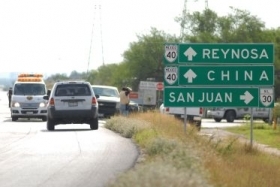The discovery of close to 50 mutilated bodies in a northeastern Mexico state, which was quickly blamed on the Zetas criminal syndicate, marks another escalation of the stakes in the country’s bloodiest and most public cartel war, and possibly a peek into the near future of how that war will unfold.
At least 49 bodies were discovered by military personnel on Sunday in Cadereyta, Nuevo Leon, along a highway connecting the country’s industrial capital Monterrey with the border town of Reynosa, Tamaulipas. Federal authorities launched an operation in order to apprehend those responsible, though no one was captured. Nuevo Leon officials subsequently fingered the Zetas as the gang likely responsible for the killings, and said the dead were members of a criminal group, and not “civilians.”
Authorities did not provide any more details of the victims, or their presumed criminal affiliation, but the Sinaloa Cartel has recently moved into Nuevo Laredo, a Zetas stronghold not far from Cadereyta, attacking their rivals and leaving dead bodies around the city over the past several weeks. It seems likely that this attack is retaliation, and that the dead are linked to Sinaloa or their allies in the Gulf Cartel (the dominant group in Reynosa), which has fought with the Zetas for control of Nuevo Leon since 2010.
[See InSight Crime’s profiles of the Zetas, the Gulf Cartel and the Sinaloa Cartel]The fighting between the Zetas and the Gulf in Nuevo Leon and Tamaulipas has been behind some of the most notorious acts of violence in recent years. Last year, the government uncovered hundreds of dead bodies discovered in clandestine mass graves in San Fernando, Tamaulipas, which were allegedly the product of a local Zetas boss pulling suspected Gulf Cartel reinforcements from interstate busses. Gunmen from the Gulf Cartel shot up a crowded nightclub in Monterrey, killing more than 20, in 2011.
The Zetas were also behind the most deadly single attack of the current Felipe Calderon presidency, although they were not targeting any of their enemies; in August of 2011, members of the criminal group set fire to a casino in retaliation for an extortion payment that had not been paid, killing more than 50 presumably law-abiding patrons in the process.
Not coincidentally, even as much of the nation has calmed, Mexico’s northeastern region has witnessed some of the most significant jumps in violence. As noted by Alejandro Hope in a piece translated by InSight Crime, during the first quarter of 2012, killings in Nuevo Leon jumped by 44 percent compared with the first quarter of 2011. The corresponding rises in Coahuila, Tamaulipas, and Veracruz, respectively, were 25, 26, and 32 percent.
The Nuevo Leon killings come just days after a dozen headless, mutilated bodies were found inside two trucks in Jalisco, a Pacific state with a significant presence of the Sinaloa Cartel. The dead were accompanied by a message attributed to the Zetas; as in Cadereyta, the victims were left along a remote portion of a heavily trafficked highway. An armed group linked to the Zetas was also recently discovered by the army in the Sierra Madre region of Sinaloa, the heartland of the Sinaloa Cartel’s dominion, and there have been sporadic attacks in the state of Sinaloa attributed to the Zetas.
Taken together, the Jalisco and Nuevo Leon killings suggest that the Zetas-Sinaloa conflict will not be limited to Nuevo Laredo, but rather is expanding across Mexico. While the two gangs have been adversaries for more than a decade, in recent years there have been relatively few examples of the two sides engaging in sustained, ongoing conflict over a given piece of turf. Instead, they have largely fought through proxies like the Beltran Leyva Organization and the Gulf Cartel. While Mexican murder rates appeared to plateau in recent months, such an expansion and intensification of the Zetas-Sinaloa conflict would deliver a significant jolt of instability to the nation just as it readies itself for a presidential election in July.
The recent incidents in Nuevo Laredo, Jalisco, and Cadereyta also promise a return of the use of mass body dumps for targeting enemies. Scores of Zetas were dumped in Veracruz in two separate incidents in September and October last year, with the Jalisco Cartel–New Generation (CJNG, for its initials in Spanish) evidently behind the attacks. In response, 26 bodies were dumped around Guadalajara, Jalisco in November; this time, the perpetrators were the Zetas, and victims were linked to the CJNG.
Prior to this recent batch of incidents, however, mass killings and subsequent displays of the dead had been rare. In addition to delivering a substantial upward jolt to Mexico’s murder rate, the regular appearance of scores of dead bodies also magnifies the fear and insecurity among the public.

